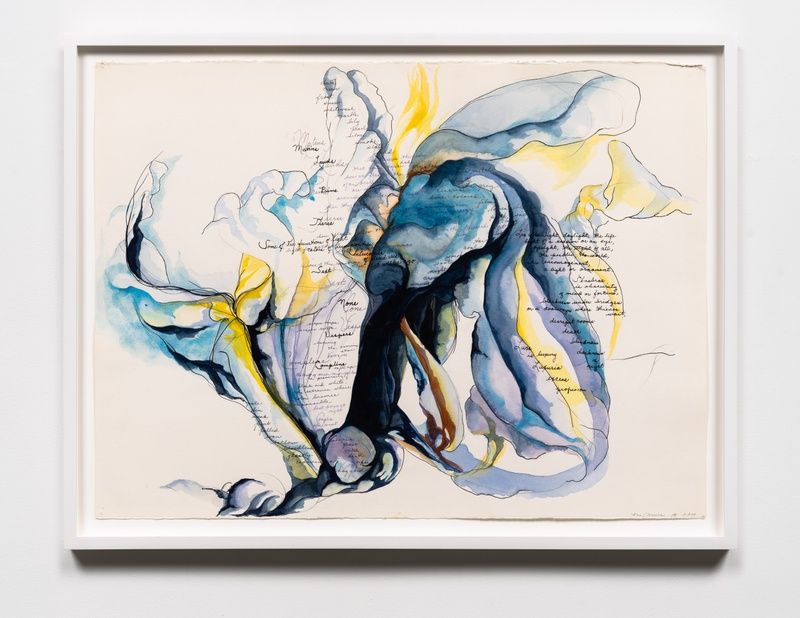James Fuentes Gallery
A STUDY IN FORM (CHAPTER ONE)
Opening reception: Tuesday, May 2, 6-8pm
A Study in Form is a two-part exhibition curated by Arden Wohl that touches upon various intersections, relationships, dialogues, and companionships between poetry and art; poets and artists. A range of generations, disciplines, and perspectives come together to push beyond the boundary of the visual artifact as an end point of the artwork. Chapter One is accompanied by a newsprint zine including new works from poets that connect directly to selected artworks on view May 3–June 3, 2023. A Study in Form (Chapter Two) will follow in early 2024 with an artist list to be announced, accompanied by the release of a new publication from James Fuentes Press that serves as both an extension and archive of the project.
Chapter One presents artworks by Marcel Broodthaers, Cecily Brown, Jessica Dickinson, Tara Donovan, Jonah Freeman, Steffani Jemison, Melissa Joseph, Leelee Kimmel, Alison Knowles & Rirkrit Tiravanija, Megan Lang, Joe Lewis, Nate Lowman, Mary Manning, Brice Marden, Rosemary Mayer, Jack Pierson, Robert Rauschenberg, Jessi Reaves, Josh Smith, Martine Syms, Danh Võ, and Jonas Wood; alongside new poetry from Alexandra Butler, Kyle Dacuyan, Kay Gabriel, Patricia Spears Jones, Mary Reilly, and David Rimanelli.
DOWNLOAD ZINE
The ecosystem of the creative individual is a hard one to quantify or categorize. Sometimes groups emerge in well-defined movements with easily transmittable names—impressionists, minimalists, feminists—though most often, these descriptive nouns and adjectives only accrue long after the fact. (Alexandra Kollontai and Sheryl Sandberg both belong to the greater history of feminism, for example, but they might be perplexed to find themselves in the same boat.) Often, these names are not self-applied and function more as a marketing device than a useful and plausible heuristic for what is happening in any given historical moment. With any group, there is an individual effort to identify shared characteristics. What is that moment today, and is the situation of culture just as important as the solitary act of creation?
This is the realm of poetry and poet: the spirit that rejects explicit meanings and easily defined packages in favor of the lyrical and allusive. To disregard the pressure of commercial spectacle in favor of the quiet and personal is to defy the misconception that resisting market trends is useless. Poetic speech has its roots in humanity’s primordial creative endeavors. Were not the first written words images? I’d say that the preservation and propagation of poetic practice is just as fundamental as that of visual artwork.
The relationship between the visual arts and poetry is long and well established. “Ut pictura poesis”—pictures like poetry, the formula of the Roman poet Horace—is among the most influential directives to artistic expression since the Renaissance. Michelangelo wrote poems. But poetic and artistic influences often wend their ways along circuitous, unexpected, and perverse routes. Gertrude Stein was as famous for her gatherings that brought together artists and writers as she was for her writing. We know her for “Three Lives” and “The Making of Americans,” but Picasso’s looming, totemic portrait intrudes forcefully even for those who haven’t read her recondite prose and star-splattered verse.
Frank O’Hara was not only a poet but also an art critic and curator at the Museum of Modern Art. Marcel Broodthaers was a poet before he embarked on his mission to make “insincere” art objects. Now he’s accounted as the Arethusa of Institutional Critique: muse of the art world compulsively biting its own tail. Brice Marden’s “Cold Mountain” paintings took inspiration from the Tang Dynasty poet Hanshan—minimalism rerouted through a Floating World. While it would be impossible to make one reducible statement about the symbiosis of poets and artists, I would propose that the nurturing of creative community brings forward a collective energy that gives way to innovations in form and approach.
Though predominantly a collection of visual art, this exhibition beats with the heart of a poet. Its ambition is to position a group of artists and writers across generations and locations who are connected by a social and artistic foment. The scene, rather than something frivolous and fashionable, becomes a space where a group fosters collective boldness in stepping outside of accepted convention. This is not a show organized around simple aesthetic or demographic similarities. This show aims for a locus where the divergence of individual efforts finds communal reciprocity and fortification. In a moment when the social and cultural noise may feel deafening—and the artist’s work seems destined for the palette racks of eyeless dream brokers—this exhibition attempts to shift focus to the communal here and now.
—Arden Wohl
Works

Jack Pierson
CRY, 2022
Metal
16 ½ × 9 ¼ × ½ inches

Martine Syms
99¢ Bowery Gang Gang, 2021
Cotton, metal, rubber, plastic, paint, and thread
38 3/8 × 25 3/4 × 18 1/8 inches

Jonas Wood
SK Witch Pot with Brain, 2022
Signed, titled, and dated verso
Gouache and colored pencil on paper
14 × 12 1/8 inches

Rosemary Mayer
Iris/Hours, 1977
Signed, titled, and dated recto
Watercolor and pen on paper
22 × 29 inches